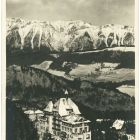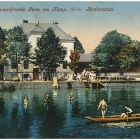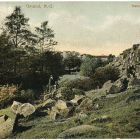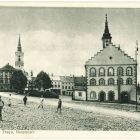Niederösterreich – 100 Jahre
Lower Austria in old Picture postcards
Lower Austria is 100 years old this year. On this occasion, the La Gacilly-Baden Photo Festival pays homage to its homeland with a photographic tribute and shows in old postcards how it all was back then.
On 1 October 1869, the postcard developed by Dr. Emanuel Herrmann was first published by the Austro-Hungarian Post. The name suggested by Herrmann was changed to “Correspondence Card” by the postal administration in Vienna. The 8.5 × 12.2 cm card could be written on freely. From 1896 onwards, the picture postcard became widely accepted, not least due to the use of newer printing processes such as chromolithography.
With 19,179.56 km², Lower Austria is the largest province in Austria. It was first mentioned as Ostarrichi in 996 A.D. On 10 November 1920, the day the Federal Constitution came into force, Vienna acquired the rights of a federal province politically independent of Lower Austria. The separation in terms of property law was decided by the end of 1921 with the so-called Separation Act. In the Nazi era called Gau Niederdonau, the northern Burgenland and southern Moravia were added to the province in autumn 1938. Almost all of these changes were reversed in 1945. Lower Austria’s development after the Second World War was hampered by the fact that the province belonged to Austria’s Soviet occupation zone. In 1986 St. Pölten became the new provincial capital. The Lower Austrian government and administration moved to Sankt Pölten in 1996. Lower Austria is divided into four quarters. Historically, the quarters correspond to the four districts of Lower Austria, an administrative unit in the monarchy. Roughly oriented to natural environments, the quartering has no political significance today. The names Wald-, Wein-, Most- und Industrieviertel have been given according to use and acquisition and dates back to the monarchy. The Alps start to take shape at the Bisamberg to the west of Vienna. In Lower Austria, the Danube changes from a mountain river to a lowland river, bringing its upper course to an end. The border between two flora regions runs through Lower Austria. The western part of the country belongs to the Central European Flora Region, while the Weinviertel belongs to the South Siberian-Pontic-Pannonian Flora Region. This is one of the reasons why Lower Austria is the most species-rich federal province. With the National Parks Thayatal and Donau-Auen, Lower Austria is the only federal province in which two National Parks are located.
This exhibition was realized with the support and know-how of the Austrian National Library ÖNB.
INFO POINT
Tourist Information Baden
Brusattiplatz 3, 2500 Baden bei Wien
Open during the photo festival:
Monday – Friday: 10.00 – 16.00 hrs
Saturday: 13.00 – 17.00 hrs (June – August)
Saturday: 13.30 – 17.00 hrs (September – October)
Closed on Sundays and public holidays!
Tel: +43 (0) 2252 86800 600
info@baden.at
Festivalbüro La Gacilly-Baden Photo
Tel: +43 (0) 2252 42269
festival@lagacilly-baden.photo






